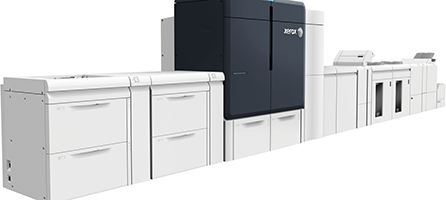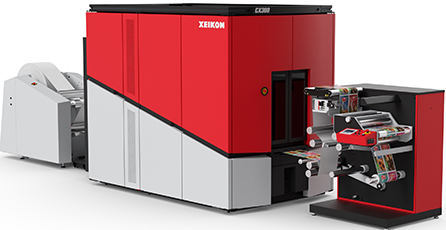
Taking the right tone
When it comes to investing in new kit for your print business, this is never an easy process and can in fact be very overwhelming when you are met with a whole host of options, all promising more than the other and each looking like a solid choice.
Filtering these down to a short list of sensible options is easier said than done, especially when it comes to market sectors where there is a wide array of high quality and reliable options. One such area is digital toner-based presses, a market that is home to some of the leading brand names in global print.
Here, we speak with some of the most well-known manufacturers in this area to find out how to go about identifying the press that is right for you, as well as learn more about their latest solutions and how these machines could be the best way forward for your business.
Automation And Growth
First up is Xerox, a brand that has been synonymous with print for many years. Kevin O’Donnell, head of marketing for Graphic Communications and Production Systems in the UK, Ireland, and Nordics at Xerox, says there are certain qualities to look for when taking on a new digital press.
“A new investment should certainly have to pay its way by producing current work more efficiently and productively but look for new capabilities that attract new customers, new volume, and new profitable revenue,” O’Donnell explains.

A new investment should certainly have to pay its way by producing current work more efficiently and productively but look for new capabilities that attract new customers, new volume, and new profitable revenue”
“It used to be quality and price but most of today’s digital presses deliver market-acceptable output and a lower price alone may not reflect the best value for the print service provider (PSP), or their customer, so in my mind buyers should be looking in two areas.
“First, automated operation. Xerox presses have high levels of automation in their DNA, reducing manual intervention, that self-monitor and adjust colour and image consistency on the fly and drive benchmark productivity, at Xerox we increasingly use new world technologies such as AI, machine learning, and analytics to achieve this.
“Secondly, look for a platform for growth. Look for a digital press that goes beyond CMYK, not just additional colours like gold, silver, white, and fluorescents, as available on the Xerox Iridesse, Versant, and Primelink. They are fantastic but also a range of capabilities such as wider paper and substrate support, smaller and larger formats, and finishing options. These may not be features you require today so make sure you have an upgrade path that protects your investment.”
An example of this, O’Donnell says, could be a Xerox Versant 280 user running CMYK who can upgrade in the field to an Adaptive Kit supporting additional colours such as gold, silver, white, clear, and fluorescent. He adds: “Market opportunities change, and you should have the ability to adapt with it.”
Xerox’s scalable portfolio of toner-based devices for the production space starts with the Xerox Primelink through to the Xerox Versant 280/4100, Xerox Iridesse and Xerox iGen5. The Xerox Versant 280 and Xerox Iridesse, O’Donnell says, are the most popular digital presses in the market, due in part to the fact that they are automated and feature rich, offering ‘Beyond CMYK’ capabilities with additional colours.

Xerox’s portfolio of toner-based devices for the production space includes the Xerox Iridesse
“No press is an island; at Xerox we believe the right press choice is important but buyers should also look to the wider ecosystem as this will support the broader business including infrastructure with service and support, workflow integration and automation, and marketing automation including ecommerce, variable content publishing, and omni-channel marketing,” O’Donnell says.
Quality Is Everything
Another leading name in this area is Canon. Carlotta Basile, production portfolio marketing manager at Canon EMEA, says PSPs should look at several key factors when investing in new kit to ensure they make an informed decision based around their unique requirements.

Carlotta Basile, production portfolio marketing manager at Canon EMEA
“One of the initial factors to consider is the print quality offered by the toner-based press,” Basile says, adding: “You should expect sharp and accurate images with consistent colour reproduction, smooth gradients, and fine details. Furthermore, a reliable toner-based press should have robust colour management capabilities, such as colour calibration, colour profiling, and be able to handle different colour spaces.
“In the print sector, quality goes hand in hand with productivity. Measured not only in speed but also with the features that support maximising return on investments (ROI). This means a consistency of print from the first to the last page, vividness of the colours and the capacity to automate where possible. Thereby reducing human error and positively impacting print schedules and ultimately being able to deliver more jobs.”
Basile adds that PSPs should also consider the range of media types the press can handle. She says the machine should be able to accommodate various paper weights, sizes, textures, and finishes, setting out that a versatile toner-based press can handle different types of print jobs, from standard documents to marketing materials and specialty applications.
With this, Basile says that often the only way of ensuring you can hit certain quality targets and customer requirements is by upgrading your kit, explaining that older machinery may not be able to deliver on certain demands.
“Newer technologies tend to deliver sharper images, more accurate colours, and improved efficiency, allowing PSPs to meet client expectations and stand out in a competitive market,” Basile says, adding: “As the efficiency of presses improves, upgrading can bring cost savings, better reliability, and improved environmental benefits. This can in turn provide long-term benefits including increasing productivity and positioning PSPs for growth and heightened customer satisfaction.”
Among the latest products is the imagePRESS V1000, which was released last year as an addition to its imagePRESS V Series cut-sheet toner press line. To date, the imagePRESS V1000, has reached over 320 installations across EMEA.
“One notable improvement in the V1000 is its transfer technology,” Basile says, adding: “This creates the optimal transport path for each sheet for every media during the printing process allowing for the production of premium applications like banners, brochures, and booklets. The press is modular and is available with a multi-drawer paper deck; the POD XL for holding up to 3,500 sheets of paper; and bypass trays to facilitate media flexibility.”
To maintain colour quality, the imagePRESS V1000 includes a built-in spectrophotometric sensor for automated press calibration and adjustment, eliminating the need for offline quality checking. An optional Sensing Unit detects prints that do not meet registration or colour settings, and automatically adjusts and maintains these parameters throughout the print run.
“With features such as these, the imagePRESS V1000 enables PSPs to tackle a wider variety of jobs and meet demanding deadlines,” Basile says, continuing:” By increasing productivity and incorporating automation for excellent print quality, we aim to free up operators' time to focus on value creation for clients and business development.
“We’ve continued to build on this range and earlier this year launched the new imagePRESS V1350.”
Freedom With Toner
Elsewhere in this market, Xeikon also has a number of products available and is well placed to offer advice and guidance to those seeking new solutions. Vice president of marketing Filip Weymans says while some consider toner to be an outdated technology with limited advancements, this perception is actually quite the opposite.
“At Xeikon, we are constantly engaged in the development of innovative application toners that are specifically designed for various end-use applications,” Weymans says, adding: “Therefore, when printers are seeking a toner-based press, they should take into account the level of freedom they gain in terms of application versatility. This will ultimately equip them with the perfect tool to maintain a competitive edge.”
Xeikon offers web-fed dry toner presses for both the graphic arts sector as well as for labels and packaging. Recognising that each segment has very specific needs, Weymans says, the manufacturer has developed application-tuned, high-quality toners to guarantee these are met cost-effectively and sustainably.
“One of the latest breakthrough innovations is TITON toner technology, which has been developed for short-run paper-based flexible packaging,” Weymans says, adding: “Also suitable for labels, pouches, and lids, it presents the perfect combination of durable, food-safe, and recyclable digital print that surpasses any other technology available. The solution caters to the increasing demand for sustainability in flexible packaging, satisfying brand owner customers and printers alike.”
At Labelexpo Europe 2023, Xeikon launched CHEETAH 3.0, a next-generation technology that features a new ECO Toner created using over 60% high-grade recycled PET, helping to reduce the carbon footprint of the printing operation by 10%. Available for high-end presses in the CHEETAH Series – the Xeikon CX300 and CX500 – new ECO Toner is also food safe.

Xeikon’s CX300 is compatible with the manufacturer’s new CHEETAH 3.0 technology and launched at Labelexpo Europe 2023
Aside from labels, Weymans says Xeikon also continues to push into the wall deco market bringing the advantages of digital to a very traditional market. Several collaborations in this sector are leveraging Xeikon’s dry toner technology to bring customisation to wallpaper and decoration.
One of these is Ahlstrom’s WallStar Digital Peel & Up customised wallpaper, which has been specifically designed to be printed on a Xeikon CX500.
O Factoid: Xeikon will soon launch CHEETAH 3.0, a next-generation technology that features a new ECO Toner created using over 60% high-grade recycled PET O
“With the design flexibility afforded by digital print in five colours, Xeikon’s dry toner technology delivers superior quality images, and importantly, complies with all regulations with regard to indoor emissions in the building industry,” Weymans says.
While the choice of new machinery will ultimately come down to the PSP and their own needs and requirements, speaking with market specialists will certainly offer plenty of food for thought and inspiration as to what to look out for on presses. Identify what is most important to your business and customers and speak with manufacturers and suppliers to match these to the machine that will have the most impact on your production.
Your text here...